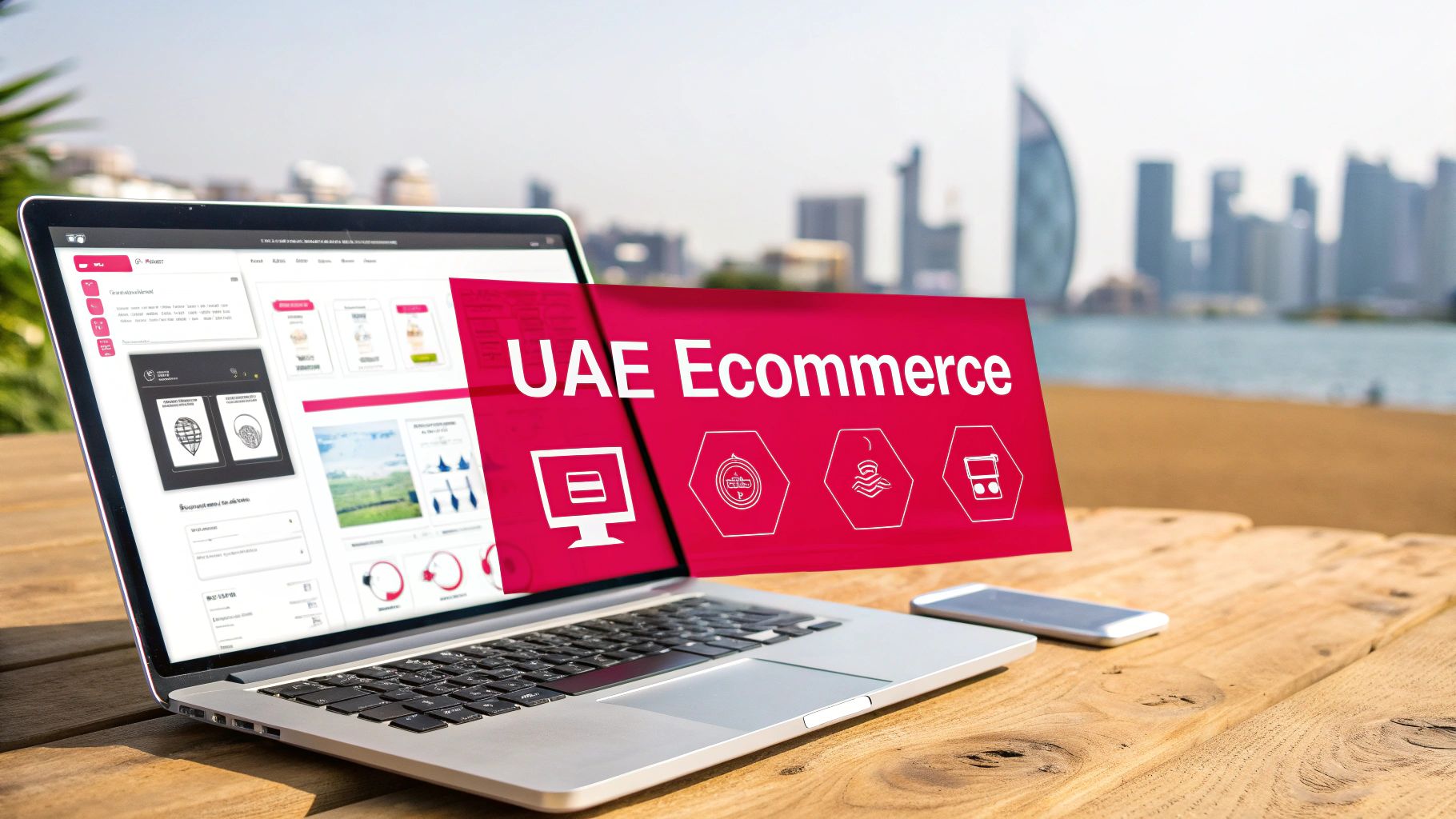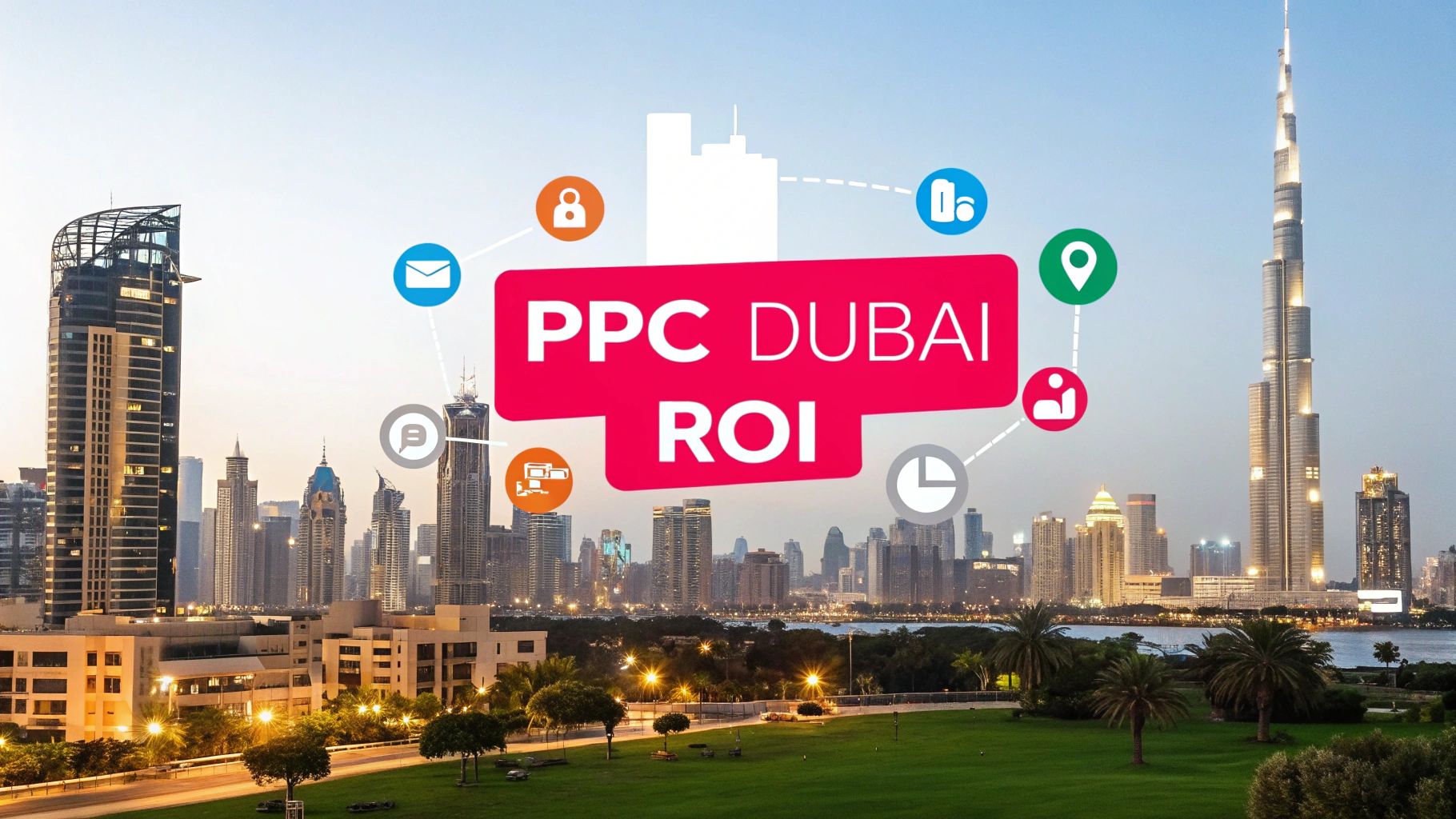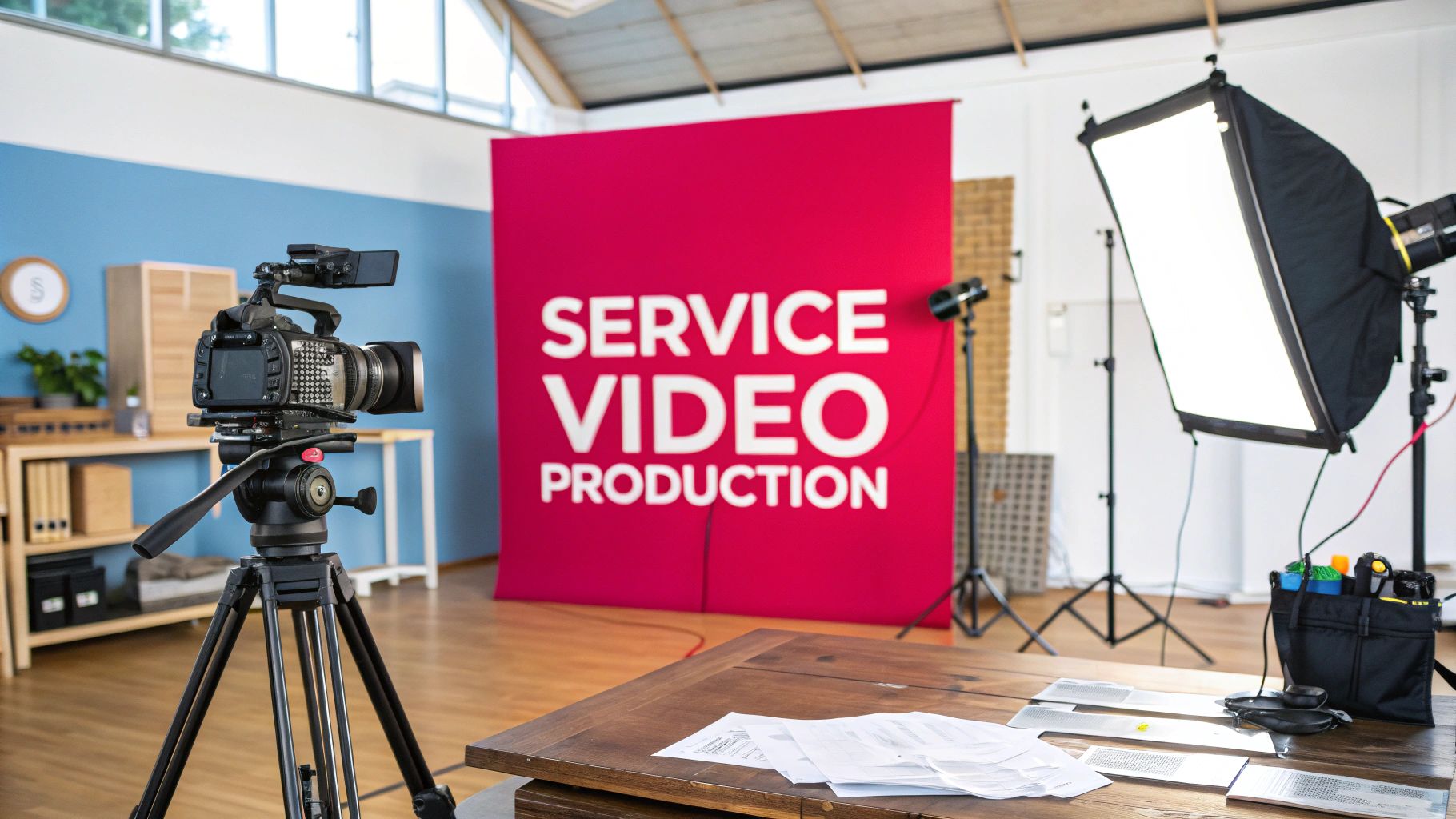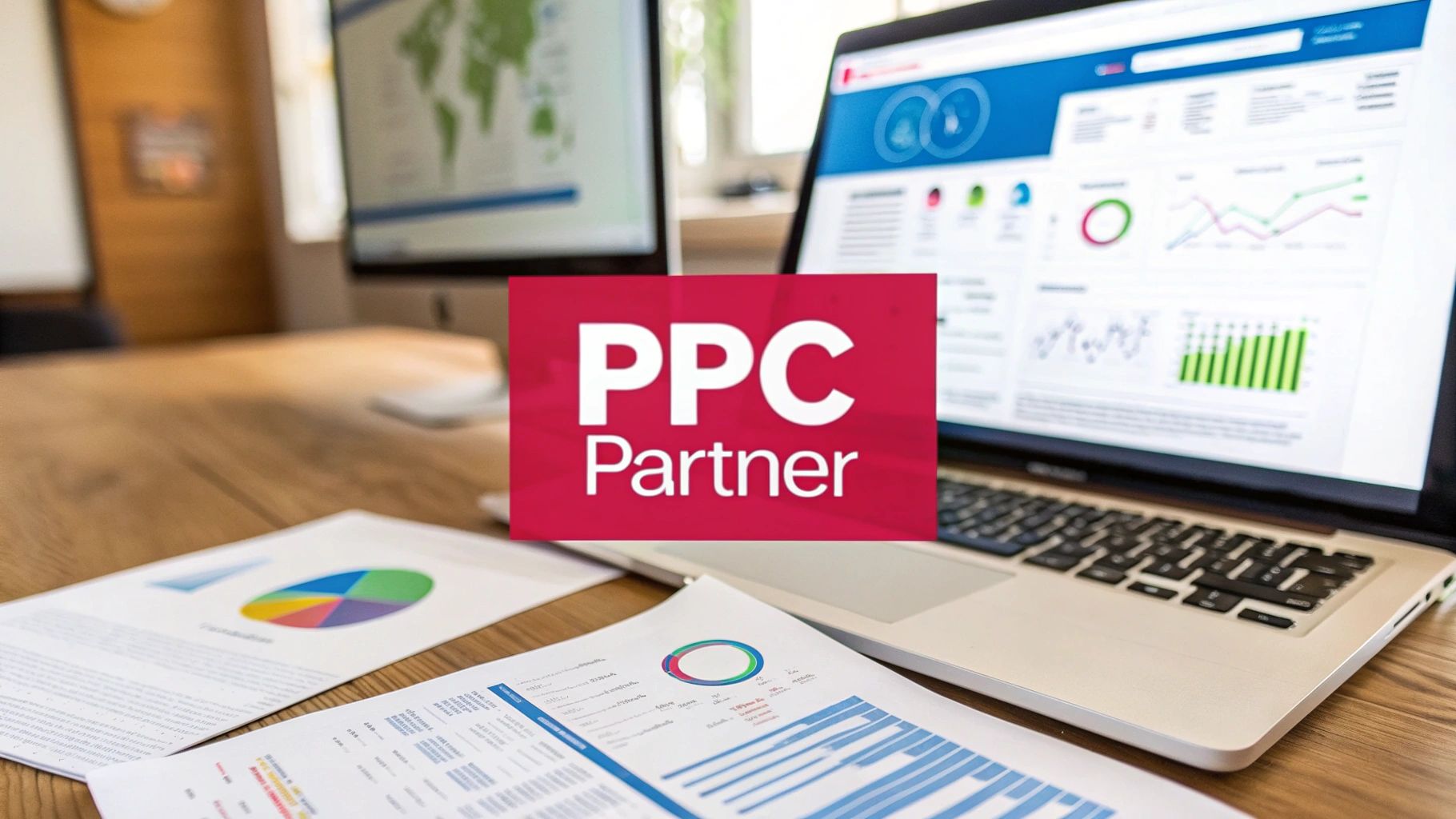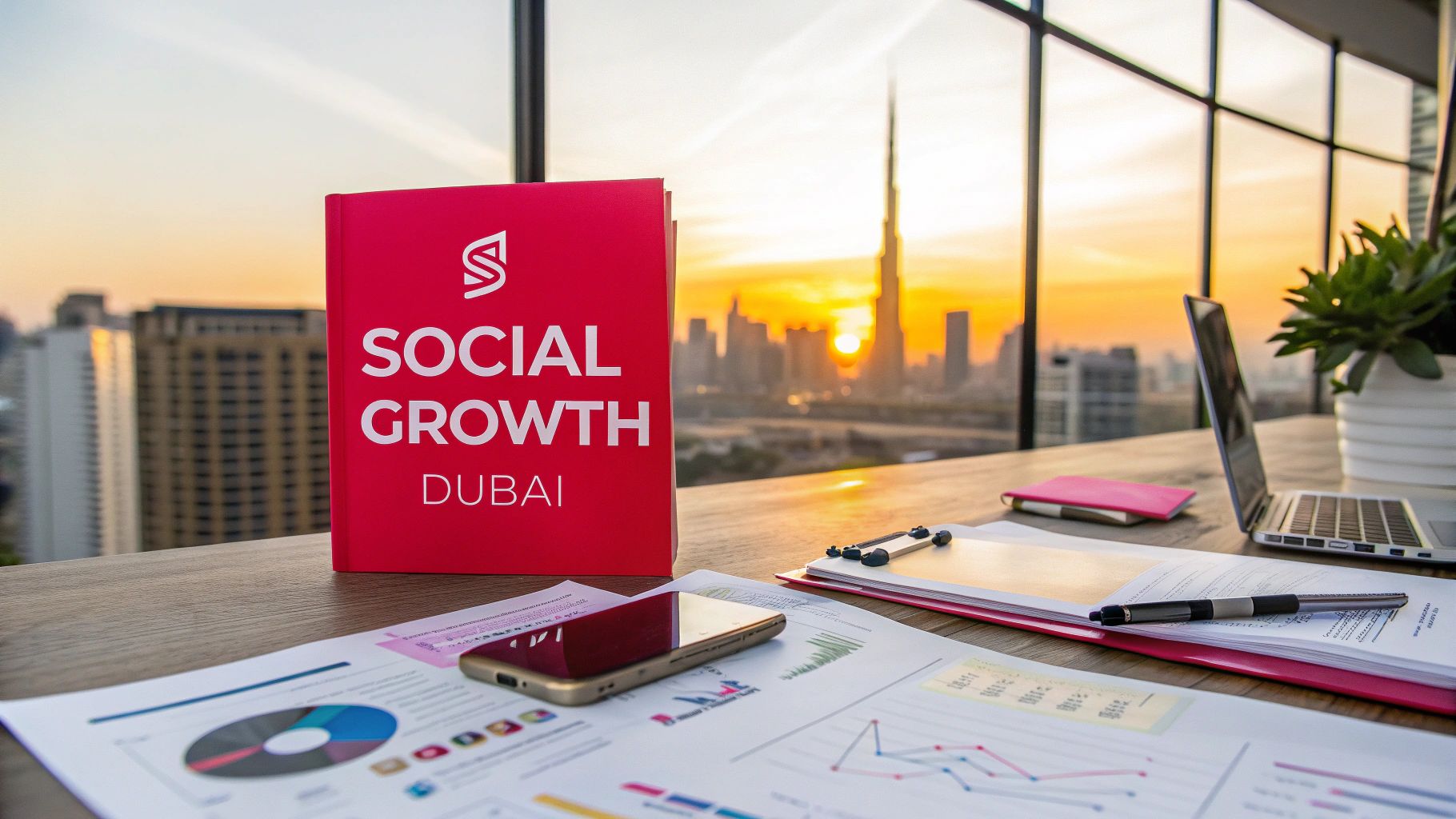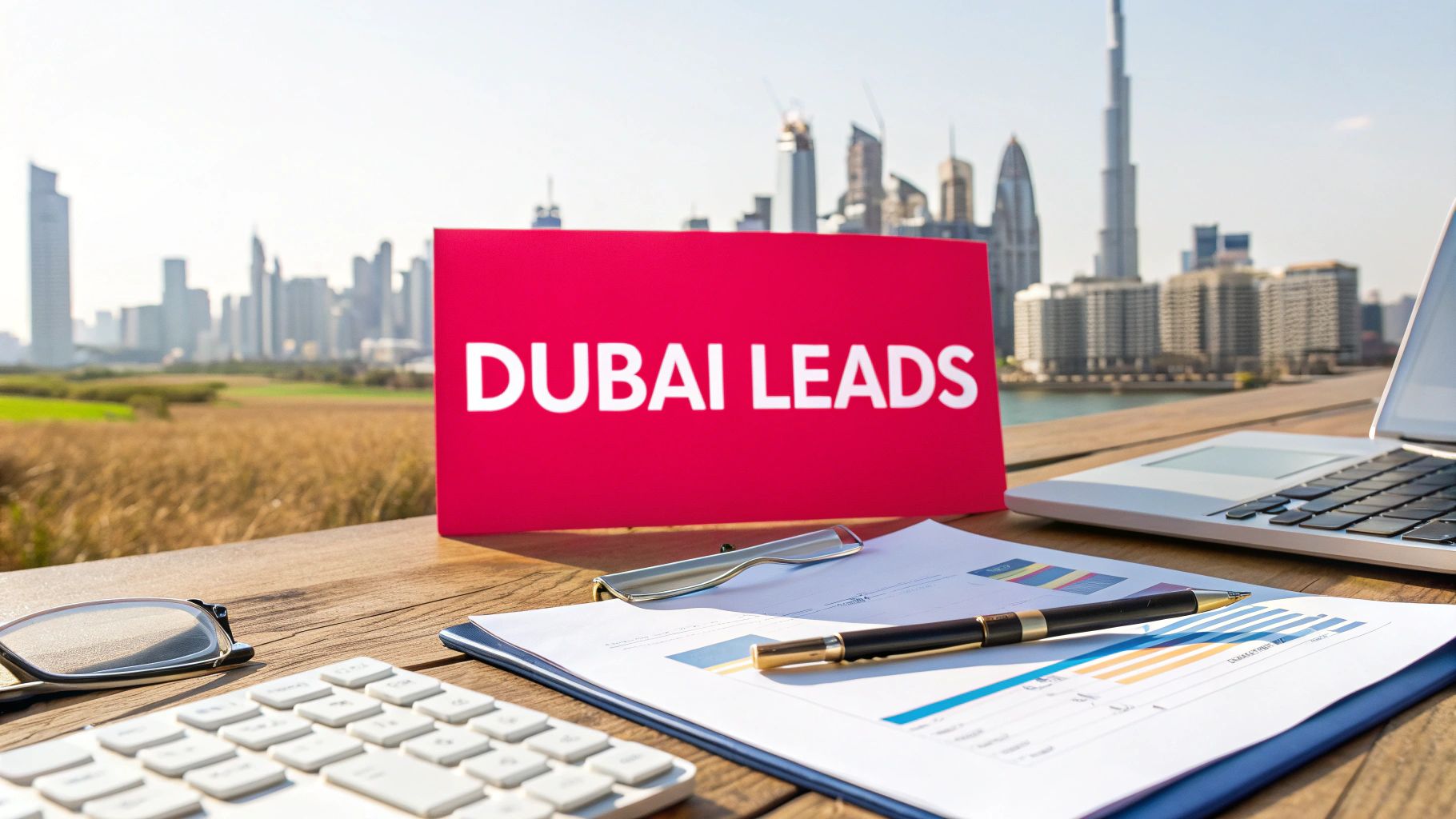Welcome to the UAE's thriving digital marketplace. It's a land of immense opportunity, but be warned: a generic, one-size-fits-all ecommerce strategy is doomed to fail here. This guide is your blueprint for success, built on a powerful blend of cultural insight, user-focused design, and technical excellence.
We'll show you how to move beyond basic templates and build an online experience that truly connects with the local audience.
Your Blueprint for Dominating the UAE Online Market
Think of your website not just as a store, but as your digital flagship in one of the world's most luxurious shopping destinations. Success in this environment demands a thoughtful approach that goes far beyond pretty pictures. It’s about creating an entire ecosystem that caters to the specific expectations and behaviours of shoppers in the United Arab Emirates.
The opportunity for brands is enormous. The UAE's ecommerce market is on a steep upward trajectory, projected to climb from $12.28 billion in 2025 to $21.18 billion by 2030. That's a compound annual growth rate (CAGR) of 11.52%.
This explosive growth is fuelled by incredible connectivity—as of early 2025, 99% of the UAE population are internet users. This creates a highly engaged and digitally native customer base ready to shop.
The Core Pillars of Success
To build a winning ecommerce site in the UAE, you need to master several key pillars that work together. If one pillar is weak, the entire customer experience can crumble. For any business serious about establishing a strong presence, understanding the local market is the first and most critical step. For a deeper look into market entry, this practical guide on expanding business internationally provides essential insights.
This guide will break down these pillars into actionable strategies:
- User Experience (UX) for the UAE Shopper: Crafting intuitive navigation and a luxurious feel that aligns with local expectations for quality.
- Authentic Localisation: Moving beyond simple translation to connect culturally through language, currency, and relevant imagery.
- Seamless Payments and Logistics: Integrating popular local payment methods and providing reliable, transparent delivery services.
- Technology and Performance: Building for a mobile-first world and optimising for the speed demanded by a tech-savvy audience.
The goal is to build an online experience that is not only functional but also deeply trustworthy and culturally attuned. This is the foundation for turning one-time visitors into loyal, repeat customers in a competitive market.
To help you get started, here's a quick overview of the essential design considerations for launching a successful online store in the UAE.
Core Pillars of UAE Ecommerce Design Success
| Pillar | Why It Matters for the UAE Market | Key Action |
|---|---|---|
| Cultural Localisation | Shoppers expect a brand to understand and respect their culture. Trust is built on familiarity. | Go beyond translation. Use local dialects, relevant imagery, and culturally appropriate marketing. |
| User Experience (UX) | The market is accustomed to high-end, seamless digital experiences. Clunky sites are abandoned quickly. | Design for intuitive navigation with a clean, premium aesthetic that feels effortless to use. |
| Mobile-First Design | High mobile penetration means most of your customers will shop on their phones. | Prioritise the mobile experience from day one, ensuring every element is optimised for small screens. |
| Local Payment & Logistics | Customers need to see payment options they know and trust, with clear delivery expectations. | Integrate popular gateways like Tabby, Tamara, and local debit cards. Offer clear shipping info. |
By mastering these core areas, you can construct a powerful online presence that not only attracts customers but also builds lasting brand loyalty. We’ll now explore each of these elements in detail, giving you the knowledge to create an exceptional ecommerce website in the UAE.
Designing a User Experience for the UAE Shopper
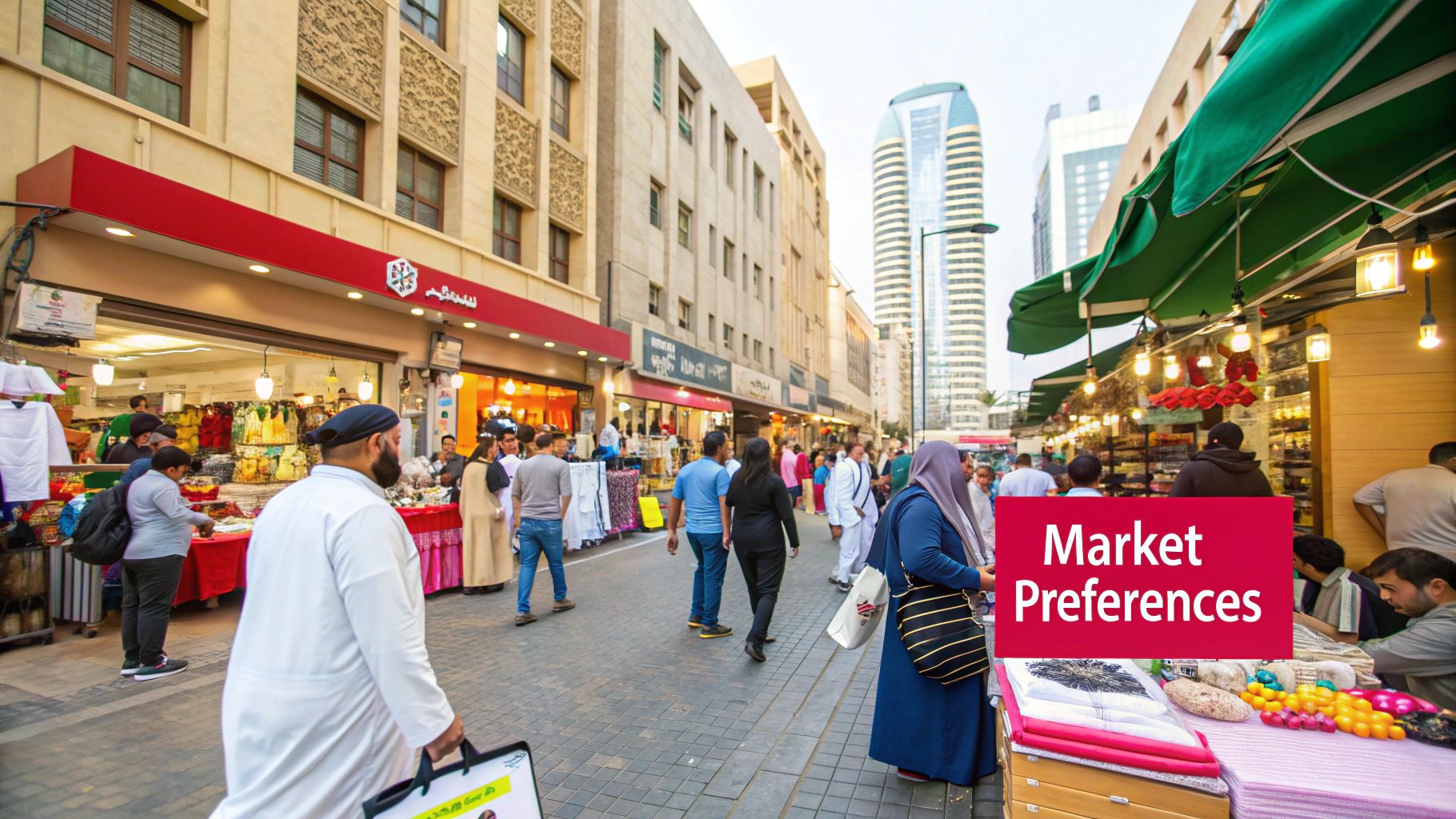
Let's get to the heart of what makes a world-class ecommerce website design in the UAE: the user experience (UX) and user interface (UI). To really connect here, you have to step beyond generic templates and think like a local shopper. What works in other markets might not land with the same impact in this region.
Think of your website's navigation like the clear, intuitive signposting in a premium Dubai mall. It should be effortless and welcoming, guiding customers exactly where they want to go without a second thought. This isn't just a nice-to-have; it's a firm expectation. A confusing layout or a slow-loading page is the digital version of a messy, unwelcoming shop, and it’s a surefire way to lose sales.
The real goal is to create an experience that feels both familiar and premium. A clunky, disorganised website can send your bounce rate through the roof because users in the UAE are used to smooth, high-quality digital interactions. So, when you invest in solid UI/UX, you’re not just polishing the visuals—you're directly building customer trust and encouraging them to stick around.
Blending Minimalism with Luxury
The visual style for a UAE ecommerce site often has to strike a delicate balance. It needs to feel modern and clean, but at the same time, it must communicate a sense of luxury and quality. The best examples often use plenty of white space, crisp typography, and stunning, high-resolution imagery.
This approach actually accomplishes a few things at once:
- Clarity and Focus: A minimalist design cuts through the noise and puts the spotlight where it belongs—on your products. It removes distractions, letting their quality do the talking.
- Perceived Value: A clean, professional look instantly elevates your brand's image. It sends a powerful message that your products are high-quality, which helps justify premium pricing.
- Faster Loading Times: Simpler designs with optimised images almost always load faster. This is absolutely critical for keeping mobile shoppers engaged, as they have very little patience for lag.
Nailing this balance makes your site feel both accessible and aspirational, a winning combination for the diverse consumer base across the Emirates.
Crafting High-Converting Product Pages
Your product pages are where window shoppers become buyers. This is arguably the most critical step in the entire customer journey and a cornerstone of any effective ecommerce website design in the UAE. To make these pages work, you need a lot more than just a "Buy Now" button.
An optimised product page is a masterclass in persuasion. It combines stunning visuals, compelling descriptions, and social proof to eliminate doubt and inspire confidence, turning a potential customer's hesitation into a confident purchase.
Start with professional, high-resolution photography. You need to show your products from multiple angles, include lifestyle shots of them in use, and even consider adding 360-degree views or short videos. In a market where quality is everything, visual proof is non-negotiable.
Next, turn your attention to bilingual descriptions. Your copy shouldn't just be a dry list of features; it needs to tell a story. Explain the benefits in both English and Arabic, using language that connects with the aspirations and values of your audience. To properly serve the UAE shopper, it's vital to implement leading ecommerce user experience best practices. This is how you build trust and dramatically improve your chances of making a sale. And for those ready to take it a step further, our guide on https://grassrootscreativeagency.com/conversion-rate-optimization-best-practices/ provides more advanced techniques.
How to Achieve True Localisation That Connects
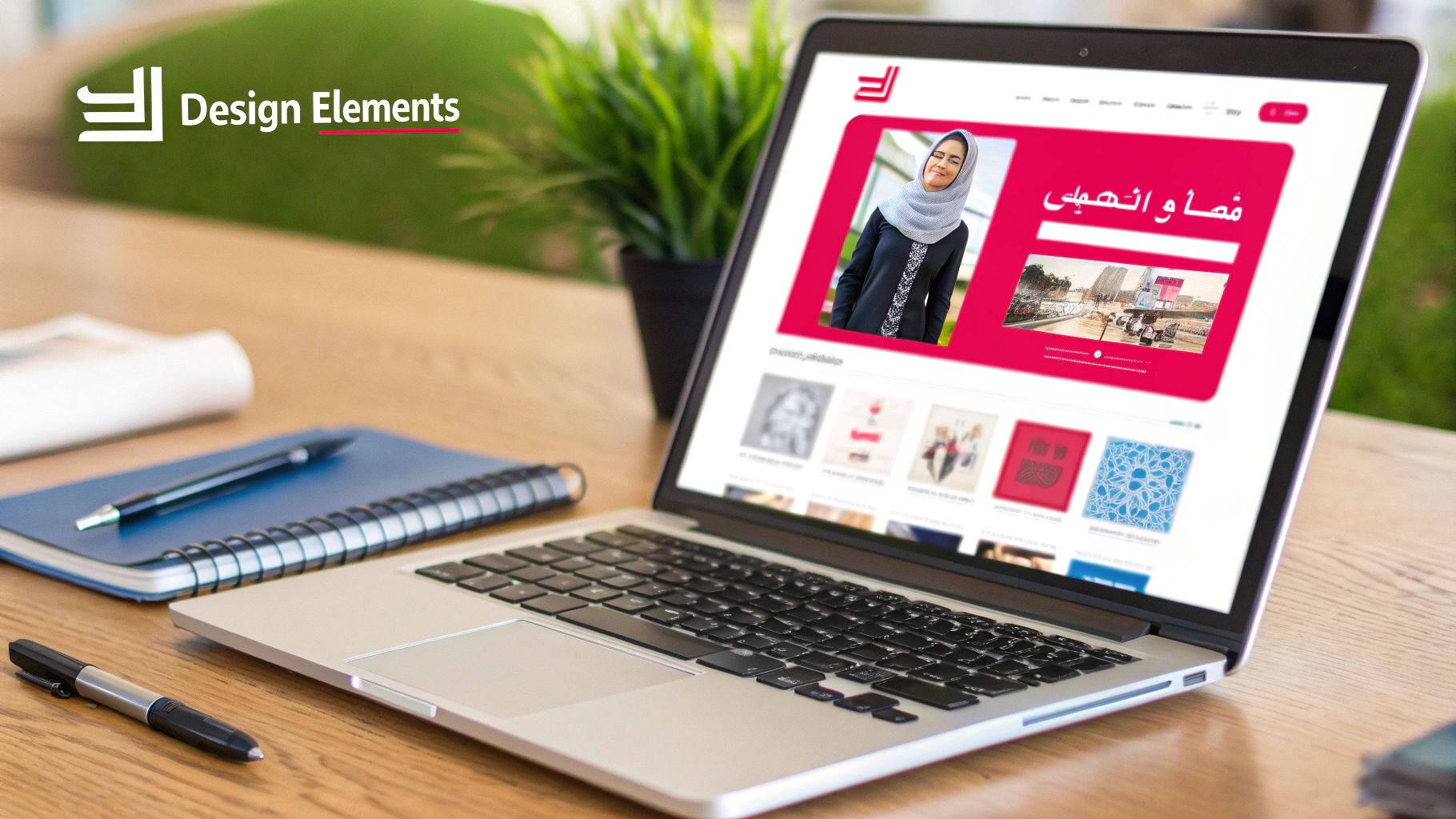
When we talk about localisation for the UAE, we're going way beyond simple translation. It’s about genuinely understanding the local culture and making your brand feel like it belongs. Just swapping English text for Arabic won't cut it. You need to adapt the entire online experience to fit with local values, habits, and expectations.
Think about it like this: if a global brand opened a physical shop in Dubai, they wouldn’t just change the sign out front. They’d tweak everything from the store layout and customer service style to the music playing in the background to create the right atmosphere. Your ecommerce website design in the UAE needs that same level of thoughtful adaptation to build real trust and connect with your audience.
Get this wrong, and you risk alienating shoppers from the get-go. A website that feels foreign or slightly "off" will always be at a disadvantage against local businesses that instinctively get the market's nuances right.
Mastering Arabic and Right-to-Left Design
The biggest hurdle—both technically and visually—is getting Arabic language support perfect. This is much more than translating product descriptions; it demands a complete overhaul of your site's layout to accommodate Arabic's right-to-left (RTL) reading direction.
This is where so many international brands stumble. They simply flip their existing design, which leads to a mess of broken layouts, jumbled text, and a user interface that feels clumsy and unprofessional. A proper RTL design rethinks the entire visual flow from the ground up.
- Navigation and Menus: All your main navigation elements need to start from the right side of the screen.
- Icons and Imagery: Visual guides, like arrows on carousels or icons in progress bars, must also be reversed to feel intuitive.
- Forms and Buttons: The order of form fields and the placement of call-to-action buttons must be re-sequenced for a natural RTL journey.
A well-executed RTL layout is a powerful sign of respect. It tells your Arabic-speaking customers that you’ve invested in creating an experience specifically for them, which goes a long way in building brand loyalty.
Aligning with Cultural and Commercial Rhythms
A truly localised ecommerce strategy means weaving your brand into the cultural tapestry of the UAE. This involves synchronising your marketing calendar, special offers, and content with the key local holidays and events that matter to your customers.
For instance, running a major sale during Ramadan or creating unique bundles for UAE National Day shows your brand is present and actively participating in the community. These campaigns feel far more authentic and relevant than generic seasonal sales that have no connection to the region.
Your imagery and messaging should also reflect local values. Ditch the generic stock photos of Western models and settings. Instead, use visuals that showcase the diverse lifestyles and people of the UAE. This simple change creates an immediate sense of familiarity and makes customers feel seen.
Presenting Prices and Promotions Correctly
How you handle pricing is a critical trust signal. All your prices must be displayed clearly and upfront in the local currency, the UAE Dirham (AED). Forcing customers to do mental maths to convert from USD or EUR adds unnecessary friction and can make your site feel less credible.
It's not just about the currency, though. Your promotional tactics should also line up with local shopping behaviours. Offers like "Buy One, Get One Free" and special product bundles are incredibly popular. And don't underestimate the power of highlighting free shipping—shoppers here have high expectations for convenience and great service.
Ultimately, effective localisation isn't just a tactic for acquiring new customers; it's the foundation for building lasting relationships. Once you've earned their business, focusing on customer retention strategies becomes the next crucial step.
By embracing these localisation principles, your ecommerce website won't just work flawlessly; it will connect on a cultural level, setting you up for sustained growth in the dynamic UAE market.
7. Mastering Payments and Logistics in the UAE
https://www.youtube.com/embed/VQraviuwbzU
A beautiful website is just the beginning. If a customer struggles to pay or their delivery is a nightmare, all that great design work goes to waste. This is where we get into the nuts and bolts of your e-commerce operation—the part that truly makes or breaks the customer experience. Your payment and logistics setup isn't just a backend function; it's the engine that drives your business and builds lasting trust.
The UAE’s payment scene is a unique blend of cutting-edge digital wallets and deep-rooted traditional habits. You can't just plug in a standard credit card processor and call it a day. To succeed here, you have to offer a mix of options that reflects how people genuinely prefer to spend their money.
One of the biggest shifts has been the explosive growth of 'Buy Now, Pay Later' (BNPL). Services like Tabby and Tamara have become essential, allowing shoppers to break down larger purchases into manageable, interest-free payments. For many customers, especially younger ones, seeing these logos at checkout is a non-negotiable. It removes the hesitation on bigger-ticket items and can give your conversion rates a serious boost.
Why Offering a Mix of Payment Methods is Crucial
While BNPL is on the rise, you can't neglect the fundamentals. Of course, standard credit and debit cards are a must-have. But it's also critical to support local debit card networks, which many residents use for their day-to-day transactions. Forgetting these basics is like closing your door to a huge chunk of potential buyers.
Then there's the one that often catches international brands by surprise: Cash on Delivery (COD). Despite the UAE being a hyper-modern, digital-first nation, a significant portion of the population still prefers the security of paying in cash only when the product is in their hands. It’s a preference built on a foundation of trust and the simple desire to inspect goods before committing.
Offering COD does come with its own set of challenges. You'll need:
- A Solid Courier Partnership: Your delivery driver is also your cashier. You need a partner who can handle cash securely and professionally.
- Flawless Communication: The customer needs to know the exact amount to have ready. Any confusion at the door leads to a poor experience.
- A Plan for Returns: Be ready for a higher percentage of refused deliveries or returns with COD. It's just part of the game, so you need to build that into your financial models.
Skipping COD is simply not an option if you want to capture the full market. The trick is to manage it with a smart, organised process.
To help you decide which payment gateways are right for your store, here’s a quick comparison of the most popular options in the UAE.
Popular Payment Methods in the UAE
| Payment Method | Key Feature | Best For | Considerations |
|---|---|---|---|
| Credit/Debit Cards | Universal acceptance (Visa/Mastercard) | All businesses; the foundational payment option | Standard transaction fees apply; ensure you support local debit schemes. |
| Cash on Delivery (COD) | Pay upon receipt of goods | Building trust with new customers; appealing to traditional shoppers | Higher operational complexity and return rates. Requires reliable courier. |
| Buy Now, Pay Later (BNPL) | Split payments into instalments | Increasing conversion on high-value items; attracting younger demographics | Integrates with services like Tabby/Tamara; service fees apply. |
| Digital Wallets | One-tap payments (Apple Pay, Google Pay) | Mobile-first shoppers looking for speed and convenience | Requires customers to have their cards saved to their devices. |
Each of these methods caters to a different consumer mindset. By offering a thoughtful selection, you signal to every type of shopper that you understand their needs and have made it easy for them to buy from you.
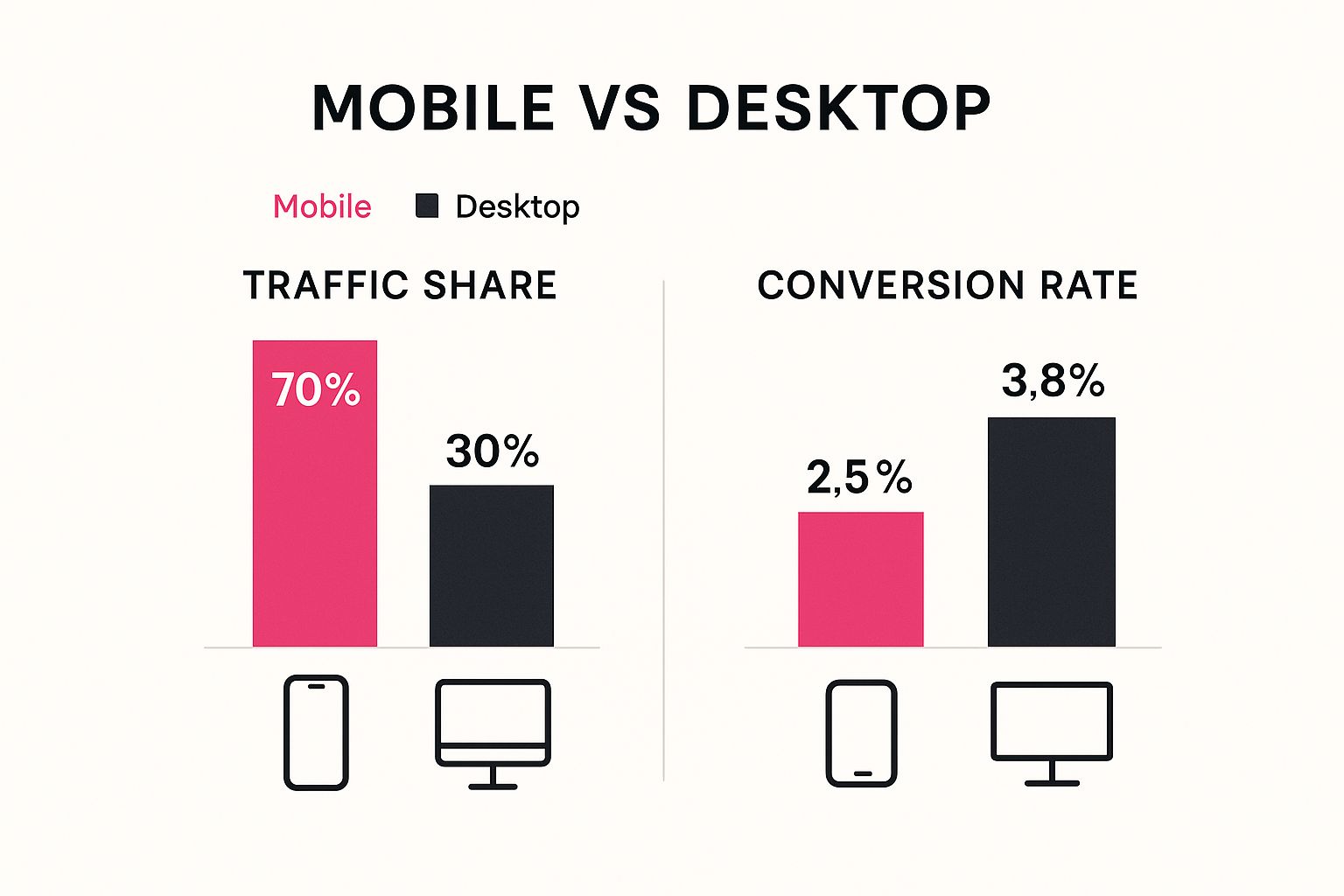
The data above shows an interesting trend: while most people browse on their phones, a higher percentage complete their purchase on a desktop. This underscores the need for an impeccable experience across all devices, from casual browsing on mobile to the final checkout on a larger screen.
Building Unbreakable Trust Through Transparent Logistics
Once the payment is confirmed, the next critical moment of truth arrives: getting the product to the customer. In the UAE, logistics isn't just about moving a box from A to B. It’s about communication, transparency, and delivering on a promise. Customer expectations are incredibly high; a generic "your order is on its way" email just won't cut it anymore.
In the UAE e-commerce market, your delivery and returns process is a direct reflection of your brand's promise. A seamless, transparent journey builds the kind of loyalty that paid ads can't buy.
To really impress your customers, you need to partner with trusted regional couriers like Aramex, SMSA Express, or Fetchr. Integrating their systems into your store allows you to give customers what they crave: real-time tracking, accurate delivery windows, and proactive updates. Your shipping and returns policies should be impossible to miss, written in plain English, and as customer-friendly as possible. As you grow, you'll need to weigh different ecommerce order fulfillment options to find the right fit for your business model.
Remember, excellent logistics isn't just good for customer retention; it can also help you get found in the first place. As our guide to https://grassrootscreativeagency.com/local-seo-in-dubai/ explains, search engines notice these operational details, rewarding businesses that provide a superior local experience.
Gaining a Competitive Edge With Smarter Tech
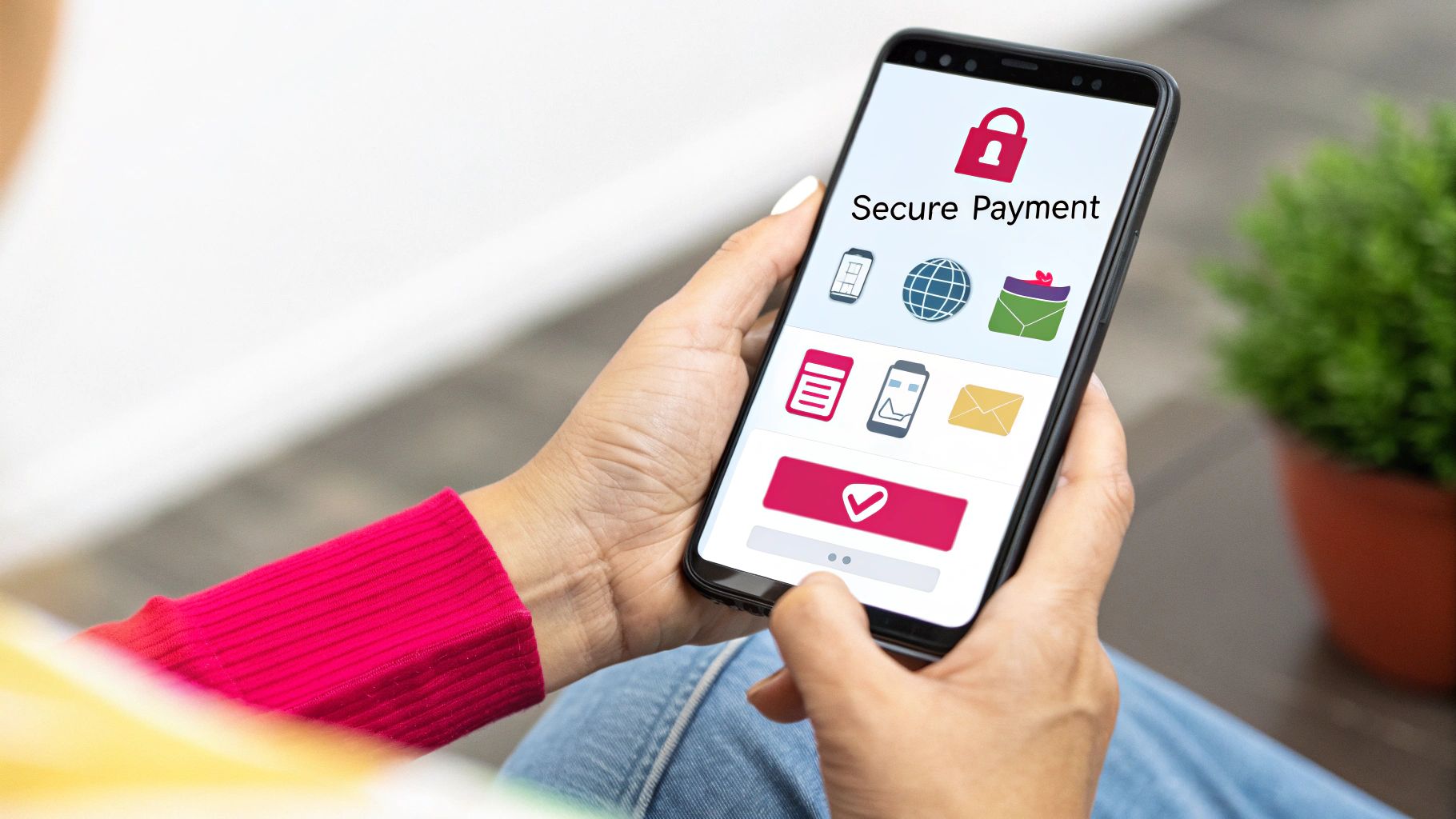
In a market as dynamic as the UAE, simply having an online shop isn't enough to stand out. The real advantage comes from using technology to turn a standard storefront into a smart, intuitive sales engine. By integrating the right tools, you can craft a shopping experience that doesn't just meet local expectations but genuinely wows them.
This is how a great ecommerce website design in the UAE goes from being a passive catalogue to an active, personal shopping assistant for every visitor. It’s all about using tech to understand what your customers really want and giving them an experience that feels like it was made just for them.
AI-Driven Personalisation
Imagine your website automatically reconfiguring its layout for every single person who lands on it, highlighting the exact products they're most likely to fall in love with. That's the magic of AI-driven personalisation. Instead of forcing everyone to see the same generic homepage, AI algorithms analyse user behaviour on the fly—what they've clicked on, what they've searched for, and what they've bought in the past.
This data is then used to generate incredibly relevant product recommendations. If a customer is looking at hiking boots, the AI can intelligently suggest complementary gear like waterproof jackets or durable backpacks. This does more than just boost the average order value; it makes the shopper feel seen and understood, turning a simple transaction into a helpful, curated experience.
An AI-powered storefront doesn't just sell; it anticipates needs. It creates a one-to-one conversation with every customer, building a kind of rapport and loyalty that generic websites simply can't achieve. This is where online retail in the region is heading.
Why Mobile-First Design is Non-Negotiable
The UAE is a mobile-first nation. This isn't just a fleeting trend; it’s a fundamental consumer behaviour that has to be at the core of your design philosophy. A "mobile-friendly" site that's just a shrunken-down version of your desktop design simply won't cut it with this audience.
The numbers don't lie. With over 72% of internet traffic in the UAE coming from mobile devices, your website must perform flawlessly on any screen. As detailed in these e-commerce web design trends on Plana.ae, top Dubai e-commerce sites are built not just as digital stores but as extensions of the brand itself, reinforcing credibility and trust.
A true mobile-first approach means thinking smaller from the very beginning:
- Designing for the Thumb: Key navigation buttons and interactive elements must be easy to reach when someone is using their phone with one hand.
- Lightning-Fast Speed: Mobile users are impatient. You need to aggressively optimise images, code, and server responses to make pages load almost instantly.
- Simple Navigation: Clean, collapsible menus and a highly visible search bar are essential to make finding products on a small screen completely effortless.
Creating Immersive Experiences with AR and 3D Visuals
So, how do you close the gap between browsing online and the tactile experience of shopping in a physical store? This is where exciting technologies like Augmented Reality (AR) and 3D product models come into play. These tools can create an interactive journey that sets your brand miles apart from the competition.
With AR, customers can use their phone's camera to "try on" a new outfit, see how a sofa would look in their own living room, or check how a watch fits on their wrist. This feature massively reduces that moment of hesitation before buying and has been proven to significantly lower return rates—a huge pain point for many online businesses.
Similarly, 3D product visuals let shoppers spin, zoom, and inspect an item from every conceivable angle. For products where the fine details matter—think luxury handbags, intricate jewellery, or high-end electronics—this level of visual fidelity can be the very thing that convinces a customer to click "Add to Cart." When you adopt these technologies, you're not just selling a product; you're offering an experience they won't forget.
Right, you’ve got a stunning design and your localisation is spot-on. But before you pop the confetti, there are two final, crucial pieces of the puzzle: navigating the legal maze and making sure your site actually performs well. These aren't just tick-box exercises; they are the bedrock of a successful online business in the UAE.
Getting the legal side wrong isn't an option—it can bring serious headaches and fines. At the same time, a slow, clunky website is a death sentence in a market full of tech-savvy shoppers with little patience. Let's make sure you get both right.
Getting Your Legal Ducks in a Row
First things first: you can't just set up shop online and start selling. The UAE has a well-defined legal framework for commerce, and that includes everything that happens online. To operate legally, you'll need a trade licence. For most online stores, this will be a specific Ecommerce Licence. You can get one from the Department of Economic Development (DED) in the emirate you're based in, or from one of the many free zone authorities.
Once you have your licence, you need to pay close attention to the rules that protect consumers and their data. These aren't just friendly suggestions; they're hard-and-fast requirements for any ecommerce website in the UAE.
- Consumer Protection: Be completely transparent. Your pricing, product descriptions, and terms of service need to be crystal clear. Make sure your returns and refunds policy is easy to find and even easier to understand.
- Data Privacy (PDPL): The UAE's Personal Data Protection Law (PDPL) is serious business. It dictates exactly how you handle customer information. You must have a clear privacy policy outlining what data you collect and why, and you absolutely need to get explicit consent from your users before you do.
Think of it like this: these rules are the digital version of a building's safety codes. They’re there to build trust, protect both you and your customers, and are simply the cost of entry for doing business here.
Optimising for Speed and Making Sure You're Seen
With the paperwork sorted, it’s time to shift gears to performance. In a market where 'instant' is the new 'fast', your website's loading speed is everything. A slow site doesn’t just frustrate potential buyers—it gets you punished by Google.
Even a one or two-second delay can send your bounce rate through the roof. The solution starts with your hosting. It might be tempting to save a few dirhams with a cheap international host, but that's a mistake. You absolutely need to use a local server in the UAE or a Content Delivery Network (CDN) with a presence in the region. This simple choice drastically cuts down latency, meaning your pages load in a flash for local shoppers.
Beyond hosting, you need to get your hands dirty with on-page optimisation. Key actions include:
- Image Compression: Use tools to shrink image file sizes without turning them into a pixelated mess.
- Code Minification: Clean up your site's code (HTML, CSS, JavaScript) to make it lighter and faster.
- Browser Caching: This clever trick lets a visitor's browser save parts of your site, so when they come back, it loads almost instantly.
Finally, none of this matters if people can't find you. That's where solid Search Engine Optimisation (SEO) comes in. This means weaving relevant keywords naturally into your site, creating genuinely useful content, and ensuring your site is technically sound so search engines can easily understand what you're about. Great performance and smart SEO are a powerful duo that drives free, organic traffic and sets you up for long-term growth.
Your Questions, Answered
Starting an ecommerce business in the United Arab Emirates can feel like navigating new territory. It’s natural to have questions. Here are some clear, practical answers to the most common queries we hear from entrepreneurs just like you.
What’s the Real Cost of an Ecommerce Website in the UAE?
This is the big question, isn't it? The truth is, the cost swings widely depending on what you need. For a straightforward, clean storefront using a ready-made platform like Shopify, you might be looking at a starting point of around 10,000 AED.
On the other end of the spectrum, if you're dreaming of a completely bespoke site with features like AI-driven recommendations, augmented reality try-ons, or deep integrations with your inventory systems, the investment can easily climb past 150,000 AED. It all comes down to matching your ambition with your budget.
Do I Really Need a Licence to Sell Online Here?
Absolutely, yes. Selling online in the UAE isn't a casual affair; you need a proper trade licence to operate legally. Most businesses get an Ecommerce Licence from the Department of Economic Development (DED) in their specific emirate or from one of the many free zones.
Think of it this way: your trade licence is the foundation of your business. It’s a non-negotiable step that builds essential trust with customers, payment gateways, and government authorities.
Which Ecommerce Platform Should I Choose for the UAE?
Two giants dominate the conversation here: Shopify and Adobe Commerce (formerly Magento). They're both fantastic, but they serve very different masters.
- Shopify: This is your go-to for speed and simplicity. It’s incredibly user-friendly, perfect for getting your store up and running quickly. Plus, its huge app store means you can add new features without needing a developer.
- Adobe Commerce: This is the powerhouse. If you have complex needs, a large product catalogue, or big plans for future growth, its limitless customisation and scalability are second to none. It’s the choice for established enterprises.
The right platform for you depends entirely on your business goals, your team's comfort with technology, and how much you plan to grow.
Ready to build an online store that truly connects with the UAE market? Grassroots Creative Agency specialises in creating data-driven ecommerce experiences that deliver results. Contact us today to start your project.

